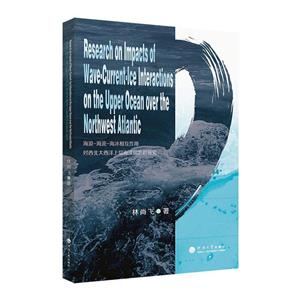扫一扫
关注中图网
官方微博
本类五星书更多>
-
>
宇宙、量子和人类心灵
-
>
考研数学专题练1200题
-
>
希格斯:“上帝粒子”的发明与发现
-
>
神农架叠层石:10多亿年前远古海洋微生物建造的大堡礁
-
>
二十四史天文志校注(上中下)
-
>
声音简史
-
>
浪漫地理学:追寻崇高景观
海浪-海流-海冰相互作用对西北大西洋上层海洋的影响研究 版权信息
- ISBN:9787563082117
- 条形码:9787563082117 ; 978-7-5630-8211-7
- 装帧:一般胶版纸
- 册数:暂无
- 重量:暂无
- 所属分类:>
海浪-海流-海冰相互作用对西北大西洋上层海洋的影响研究 内容简介
本书研究了海浪-海流-海冰相互作用中的重要物理过程对西北大西洋上层物理环境的影响及其动力机制。首先通过建立海浪-海流-海冰的单向耦合模型,研究在海流和海冰影响下的波浪成长、耗散及传播。考虑波浪对海气交换的影响,基于观测资料发现了不同海况下海表粗糙度关于波龄的不同关系,提出并验证了新的海表粗糙度参数化方案。针对波浪浅水破碎的过程,提出并验证了破碎指标关于地形坡度的非线性公式。上述参数化方案被用于首个西北大西洋波流全耦合模型,研究了飓风期间西北大西洋的波流相互作用过程。结果表明波流相互作用显著改变着海洋表层水动力,且能够影响到上百米水深。波致应力、波浪混合、波浪增强的风应力和底摩阻在不同的条件下对海洋环境都能起到主导作用,因而其影响对复杂多变的海洋都是不容忽略的。
海浪-海流-海冰相互作用对西北大西洋上层海洋的影响研究 目录
ABSTRACT
ACKNOWLEDGEMENTS
CHAPTER 1 INTRODUCTION
1.1 Background
1.1.1 Ocean Surface Wave
1.1.2 Wave-Ice Interactions
1.1.3 Wave-Current Interactions
1.2 Objectives
1.3 Outline
CHAPTER 2 PERFORMANCES OF VISCOELASTIC MODELS FOR OCEAN WAVE DISSIPATION IN ICE-COVERED REGIONS
2.1 Introduction
2.2 Methodology
2.2.1 Spectral Wave Model and Wave Dissipation in Ice
2.2.2 Wave Model Setup
2.2.3 Model Forcing
2.2.4 Wind and Wave Observations
2.3 Model Validations
2.3.1 Wind Forcing
2.3.2 Significant Wave Height
2.3.3 Peak Wave Period
2.4 Results
2.4.1 Determination of Ice Rheological Parameters
2.4.2 Comparisons of Two Viscoelastic Models for Wave Dissipation
2.4.3 Effects of Wave Scattering on Wave Propagations
2.5 Discussion
2.6 Conclusions
CHAPTER 3 DEPENDENCES OF DRAG COEFFICIENT ON WIND SPEED AND WAVE STATE
3.1 Introduction
3.2 Drag Coefficient at the Sea Surface
3.3 Observational Data
3.3.1 FETCH
3.3.2 GOTEX
3.3.3 Grand Banks Experiment
3.3.4 HEXMAX
3.3 . J North Sea Experiment
3.3.6 RASEX
3.3.7 SWADE
3.3.8 WAVES
3.4 Analyses of Observational Wind Stress and Wave Data
3.4.1 Wind-speed-dependent Drag Coefficient
3.4.2 Wave-dependent Drag Coefficient
3.4.3 A New Parameterization of the Drag Coefficient
3.4.4 Assessment of Existing and New Parameterizations
3.5 Wave Simulations Using Different Drag Coefficient Parameterizations
3.5.1 Spectral Wave Model and Setup
3.5.2 Model Forcing
3.5.3 Wind and Wave Observations
3.5.4 Wave Model Results
3.6 Discussion and Conclusions
CHAPTER 4 PERFORMANCES OF WAVE BREAKING PARAME-TERIZATIONS IN THE SPECTRAL WAVE MODEL
4.1 Introduction
4.2 Model Description and Depth-induced Wave Breaking Parameterizations
4.2.1 Spectral Wave Model
4.2.2 Existing Parameterizations for Depth-induced Wave Breaking
4.2.3 A New Parameterization for Depth-induced Wave Breaking
4.3 Observational Data and Methodology
4.3.1 Laboratory and Field Observations
4.3.2 Wave Model Setup
4.4 Results and Discussion
4.4.1 Performances of Six Existing Parameterizations
4.4.2 Effect of Bottom Slope and Normalized Water Depth
4.4.3 Calibration and Validation of the New Parameterization
4.5 Conclusions
CHAPTER 5 WAVE-CURRENT INTERACTIONS DURING HURRI-
CANES EARL AND IGOR
5.1 Introduction
5.2 The Coupled Wave-Circulation Model
5.2.1 Ocean Wave Model
5.2.2 Ocean Circulation Model
5.2.3 Model Configurations
5.3 Observational Data
5.4 Hurricanes Earl and Igor
5.5 Effects of Currents on Waves
5.5.1 Significant Wave Height
5.5.2 Peak Wave Period
5.5.3 Wave Spectra
5.5.4 Maximum Significant Wave Height
5.6 Effects of Waves on Circulations
5.6.1 Sea Level
5.6.2 Sea Surface Current
5.6.3 Sea Surface Salinity
5.6.4 Sea Surface Temperature
5.6.5 Vertical Structure of Temperature
5.7 Summary and Conclusions
CHAPTER 6 CONCLUSIONS
6.1 Main Results and Their Significance
6.2 Future Work
APPENDIX A STATISTICS FOR MODEL COMPARISONS
APPENDIX B DEPENDENCES OF WAVE DISSIPATION ON ICE AND WAVE PROPERTIES
BIBLIOGRAPHY
展开全部




















